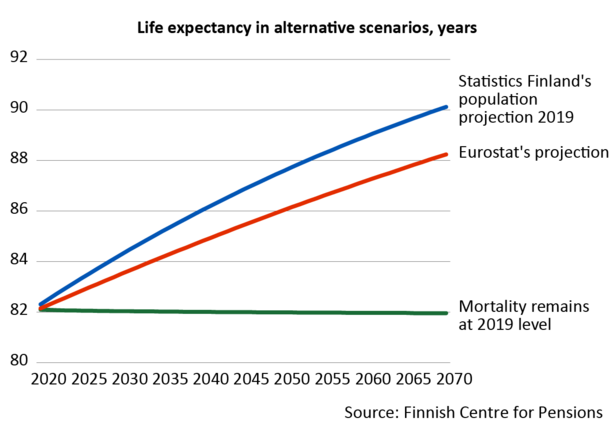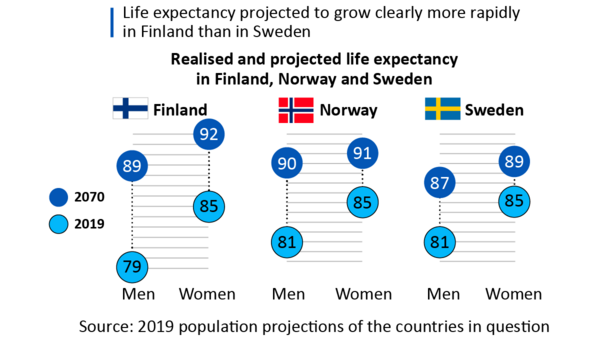Growth of life expectancy of Finns may be slower than expected

The development of mortality greatly impacts the end results of pension projections. According to Eurostat’s population projection, the gaps in EU countries’ expected longevity will narrow. Eurostat projects that life expectancy in Finland will grow at a slower pace than projected by Statistics Finland. This would slow down the rise of the retirement age and improve pension benefits compared to national projections.
The growth in pension expenditure and pension payments is not only due to low birth rates; extended longevity makes a significant impact, as well.
The report of the Finnish Centre for Pensions illustrates the effects of the growth in life expectancy on pension financing, pension benefits and the retirement age. The report compares scenarios that are alternative to the baseline projection of the Finnish Centre for Pensions, which is based on Statistics Finland’s 2019 population projection.
In 2019, life expectancy for men was 79.2 years and for women 84.5 years. If life expectancy were to remain at the current level, the pressure to raise the contribution level of pensions under the Employees Pensions Act (TyEL) would be removed almost completely.
If life expectancy were to stop growing, the stable, sustainable contribution level would be reduced by slightly less than two percentage points to 25 per cent, which is close to the current contribution level. A stable, sustainable contribution level means a TyEL contribution level with which future pensions can be financed.
However, it is realistic to assume that life expectancy will continue to grow also in the future, but perhaps not as rapidly as previously projected.
“Population projections have assumed that life expectancy continues to grow rapidly. In recent years, experience from other industrial countries and the current corona pandemic raise the question of for how long the positive trend can continue. This is why it is justified to review also alternative development scenarios,” says director Jaakko Kiander (Finnish Centre for Pensions).
Projection for Finland the highest of all countries of comparison
According to the population projection of Statistics Finland, which the baseline projection of the Finnish Centre for Pensions is based on, life expectancy is assumed to grow clearly faster in Finland compared to the other countries of comparison (for example, Germany and Sweden) in the long run. Only in Norway is life expectancy projected to grow at the same pace as in Finland.
Eurostat’s projection (Europop2019) assumes that the gaps in life expectancy between EU Member states will narrow. In countries with higher-than-average life expectancy, such as in Finland, the growth is expected to be slower than average while it is expected to be faster-than-average in countries with low life expectancy.
According to Statistics Finland, life expectancy of Finns will be over 90 years in 2070. According to Eurostat’s projection, life expectancy is around two years lower, or over 88 years. In both projections, the gender gap will narrow but not disappear.
By 2070, men’s life expectancy is projected by Statistics Finland to grow by 10 years and be 89 years while that of women is projected to grow by 7 years to 91.5 years. The equivalent figures in Eurostat’s projections are 86 years for men and 90.5 years for women.
“Statistics Finland’s projection is more optimistic than those of other European countries and that of Eurostat. Finnish mortality is predicted to continue decreasing in the same way as it has done since the end of the 1980s”, explains mathematician Tuija Nopola (Finnish Centre for Pensions).

Lower life expectancy means lower retirement age
Two automatic adjustment mechanisms take life expectancy into account in earnings-related pensions. First, the life expectancy coefficient adjusts pensions according to rising life expectancy. Second, the earliest eligibility age for the old-age pension is linked to life expectancy.
This is why the development as projected by Eurostat would only slightly reduce the pressure to raise pension contributions. Instead, pensions would be higher and the earliest eligibility age for the old-age pension lower than in the baseline projection.
In the baseline projection of the Finnish Centre for Pensions, the earliest eligibility age for an old-age pension for those born in 2000 is 68 years and 2 months. In Eurostat’s projection it is 7 months less: 67 years and 7 months.
In the baseline projection, the ratio of the average pension to the average earnings will decline from the current level (52%) by around 10 percentage points to 43 per cent by 2070. This decline is due to, among other things, the effect of the life expectancy coefficient. Using Eurostat’s mortality assumptions, the ratio declines slightly less, to around 44 per cent.

Publication:
How mortality affects the pension system, Finnish Centre for Pensions, Reports 2/2021 (Julkari)
